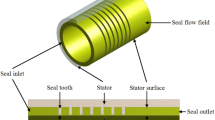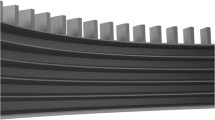Abstract
This paper addresses the issue of reciprocating compressors staggered labyrinth seal structure. The internal flow field of sealed structure, the displacement of cylinder and piston for different tooth profile angles are analyzed synchronously using FLUENT software, and the effects of fluid-structure interaction on the performance of the labyrinth seal are revealed. The results indicate that with the growth of tooth profile angle, the leakage rate of labyrinth seal tends to decrease first, and then increase. The results of fluid-structure interaction analysis are close to those of actual engineering. The effect of fluid-structure interaction makes tiny deformation in calculation mesh of piston and cylinder structure, and the coupling interaction affects the performance of the labyrinth seal.
Similar content being viewed by others
References
Huang Xiao-guang, Wu Ding-yi, Wang Yong-hong, et al. Experiment research on flow field and heat transfer in straight labyrinth seal of the aircraft engine [J]. Journal of Aerospace Power, 2000, 15(2): 159–163 (in Chinese).
Wu Ding-yi. Analysis and comparison of two commonly used labyrinth seal and critical features [J]. Journal of Aerospace Power, 1997, 12(4): 397–400 (in Chinese).
Wu Ding-yi. Study of the straight labyrinth seal flow field [J]. Fluid Machinery, 1997, 25(2): 11–14 (in Chinese).
Wang Suo-fang, Lü Hai-feng, Xia Deng-yong. Numerical analysis and experimental research of seal labyrinth structure features [J]. Journal of Nanjing University of Aeronautics and Astronautics, 2004, 36(6): 732–735 (in Chinese).
Huang Shou-long, Wang Zu-yao, Ma Da-wei. Flow analysis influence of cavity inclination on labyrinth leakage [J]. Journal of Propulsion Technology, 1995, 16(2): 40–45 (in Chinese).
Liu You-jun. Study on sealing mechanism of a crenellated radial labyrinth seal [J]. Lubrication Engineering, 2002, 154(6): 20–21 (in Chinese).
Li Lin, Liu Wei-hua. Study of mechanism of labyrinth seal based on FLUENT [J]. China Mechanical Engineering, 2007, 18(18): 2183–2186 (in Chinese).
Versteeg H K, Malalasekera W. An Introduction to computational fluid dynamics: The finite volume method [M]. New York: Wily, 1995.
Zhu Gao-tao, Liu Wei-hua. Analysis of calculational methods on leakage for labyrinth seals [J]. Lubrication Engineering, 2006, 31(4): 123–126 (in Chinese).
Author information
Authors and Affiliations
Corresponding author
Additional information
Foundation item: the Science and Technology Projects of Liaoning Province (No. 2012219020) and the China Postdoctoral Science Foundation (No. 2013M541249)
Rights and permissions
About this article
Cite this article
Tang, Hn., Wang, Sj. & Zhao, J. Effect of fluid-structure interaction on sealed flow field and leakage rate based on computational fluid dynamics. J. Shanghai Jiaotong Univ. (Sci.) 20, 326–330 (2015). https://doi.org/10.1007/s12204-015-1631-x
Received:
Published:
Issue Date:
DOI: https://doi.org/10.1007/s12204-015-1631-x




